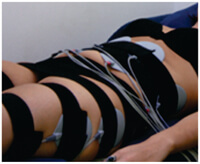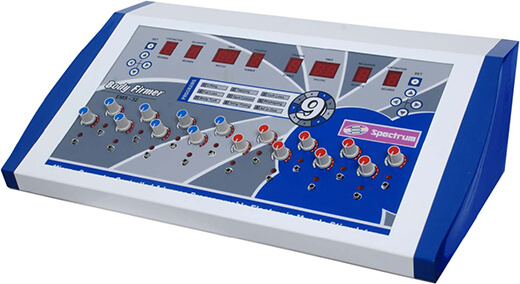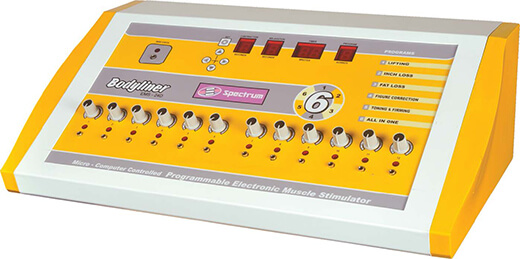Multi Channel Interferential Stimulator
This type of stimulation is characterized by the crossing of two electrical medium , independent frequencies that work together to effectively stimulate large impulse fibers. Because of the frequency the interferential wave meets low impedances. When crossing the skin to enter the underlying tissue. This deep tissue penetration can be adjusted to stimulate motor nerve fibers for increased contraction of muscle. Interfenetial stimulation differs from NMS because it allows a deeper penetration of the tissue with more comfort and increased circulation.
BENEFITS
- Immediate inch loss
- Spot & volume reduction
- Selective firming action of very specific & difficult body portions i.e. Buttocks, abdomen, thighs &for pot belly
FEATURES
- Micro computer controlled
- 6 channels, 24 pads output (Spectra Plus)
- 4 channels , 16 pads output(Spectra)
- Digital Display
- 4 Programmes(IFT,IFT VECTER,BI-POLAR & RUSSIAN)
- Selectable - Timer, Cyclic ON, Cyclic OFF, Base freq.,Sweep freq.
- Digital display of % power and balance treatment time.
- Feathe touch Controls


Spectra Plus
IFT - 24

Spectra
IFT - 16
Programmable Advance Electronic Muscle Stimulator
Neuromuscular stimulation uses low frequencies to stimulate contraction of muscles. This low frequency electrical current is similar to the electrical impulses produced by the brain to perform a contraction of muscles. Neuromuscular stimulation uses electrical impulses by lead wires and electrodes to bring the electrical current to an individual muscle or muscle group. A contraction and relaxation rhythm is created in the muscle which helps to relieve muscle spasms, re-educates muscles, advances range of motion and resumption of motor control, helps prevent or retard muscle atrophy from disuse and increase local blood circulation. The treatment is safe and without any side effect and after the initial newness of the tingling sensation from the electrical current, can even become relaxing for the patient.
BENEFITS
1. figure trimming for women- Flatten your stomach
- Reshape your butts
- Trim your thighs
Uplift, firm & strengthen (flatten), sagging abdomen bottom, thighs and breasts.
3. body firming for men
Accelerates muscle buildup, tone & firm and strengthen abdomen, midriff bulge, pecks, biceps, triceps & potbelly.
FEATURES ( BODYFIRMER )
- Micro- computer controlled
- 16 channels, 32 pads output
- Dual Digital display
- 9 programs (lifting, tapping, inch loss, fat loss, figure correction, reshaping, body tuck, toning & firming & all in one)
- Selectable - programs(1-9), treatment time (1- 60 minutes), contraction time( 1 - 9 seconds) & relaxation time (0 - 9 seconds) & each channel has independent intensity controls
- Dual programs can be used simultaneously
FEATURES ( BODYLINER )
- Micro- computer controlled
- 12 channels, 24 pads output
- Digital display
- 6 programs ( lifting, inch loss , fat loss , figure correction, toning & firming & all in one )
- Selectable - programs(1-6), treatment time (1- 60 minutes), contraction time( 1 - 9 seconds) & relaxation time (0 - 9 seconds) & each channel has independent intensity controls
- Wire Check Facility


Bodyfirmer
EMS - 32

Bodyliner
EMS - 24'D'



